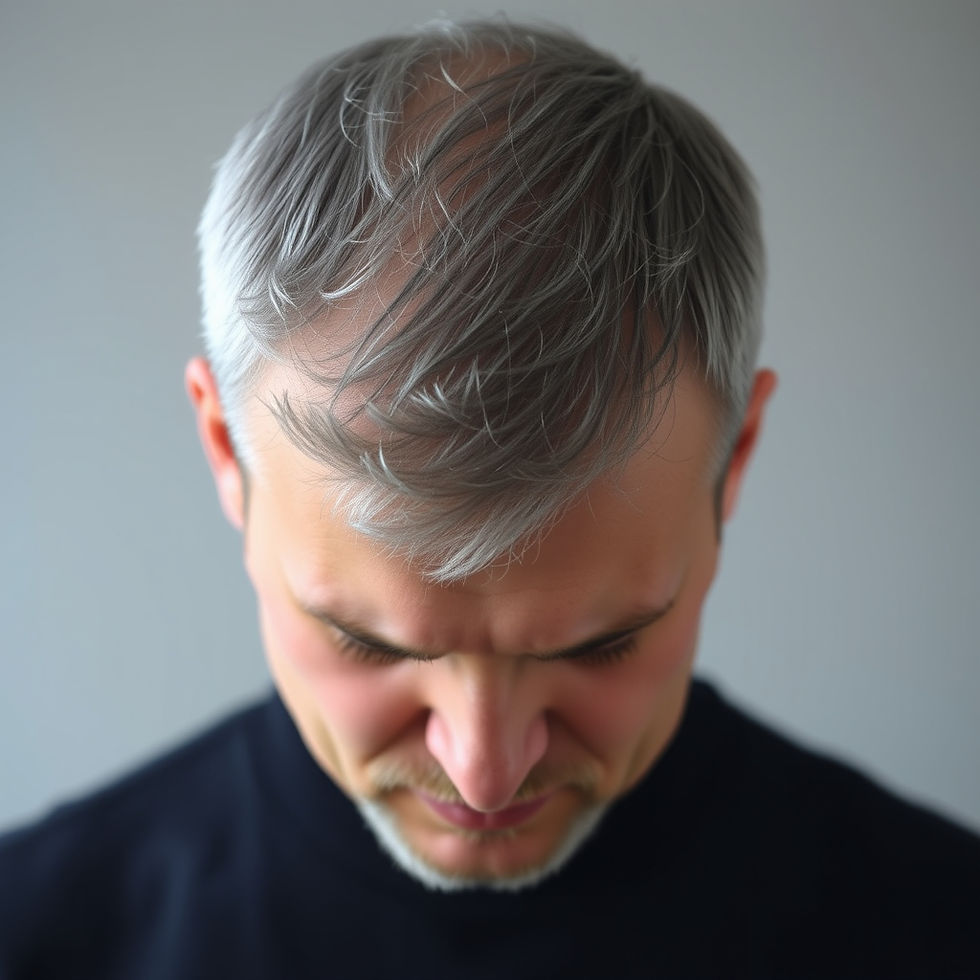Can Eating Well Slow Balding or Hair Greying?
- Erika Rawes
- Jul 28
- 4 min read
Updated: Aug 6
The way our hair looks is a big part of our overall appearance. But as we age, we can experience hair loss or hair greying. By age 35, two out of three men experience some degree of hair loss, according to the American Hair Loss Association. A PubMed Study also found that roughly three out of four people between 45 and 65 are affected by grey hair (with an average intensity of 27%).
Every year, people spend billions of dollars on varying "fixes"-- shampoos, serums, and supplements promising thicker, darker, or more youthful hair. But what if part of the answer isn’t in a bottle at all? Could the food you put on your plate actually make a difference when it comes to hair loss and greying? We examine this very question below.

Hair Biology 101
Hair grows from follicles under your skin. The shape of your hair follicles determines whether your hair is curly, straight, or wavy. Each follicle produces hair through a cycle of growth, rest, and shedding. Balding (especially pattern baldness) happens when follicles shrink and stop producing thick hair strands, eventually leading to less and less hair.
Greying happens when the pigment cells (melanocytes) in the follicle slow or stop producing melanin (the pigment that gives hair color). Genetics are the biggest factor in both, but environmental and lifestyle factors—including diet—can also influence how quickly these changes happen.
Can Diet Help with Hair Growth?
Our hair is made mostly of keratin, a structural protein. To keep producing strong strands, our hair follicles need a steady supply of building blocks and nutrients. If we have deficiencies in nutrients like protein, iron, zinc, and certain vitamins, this could possibly lead to thinning or shedding. Here are examples of how nutrient deficiencies impact hair:
Protein: Essential for keratin production.
Iron: Low iron is a known cause of hair shedding, especially in women.
Zinc: Plays a role in repairing and maintaining hair follicles.
Vitamin A: Helps make the scalp healthy and helps with sebum production.
Vitamin C: Helps with collagen production and iron absorption.
Vitamin D: Associated with follicle health, and deficiencies in vitamin D are associated with hair thinning.
Vitamin E: Antioxidant and helps protect follicles from oxidative damage (damage from an imbalance/excessive free radicals).
Omega-3 fatty acids: May help reduce inflammation around follicles, promoting a healthier scalp environment.
What About Grey Hair?
Hair greys for a few reasons, but hair greying is mainly a result of oxidative stress in the follicle and the gradual depletion of melanocytes (those pigment-producing cells we discussed above). Some studies suggest that diets rich in antioxidants and certain B vitamins (especially B12, folate, and biotin) may help delay the process by reducing oxidative damage. Minerals like copper are also involved in melanin production.
A 2020 review in Dermatologic Therapy highlighted that premature greying can be linked with deficiencies in B12, folic acid, and biotin. Another study found that low serum copper and iron levels correlated with early greying in young adults.
Can Eating Well Reverse Hair Greying or Balding?
If your hair is thinning or greying due to a nutrient deficiency, improving your diet can sometimes reverse or slow the process. However, if the root cause of your hair greying or balding is genetics, diet alone can’t completely stop it—it can only help you maintain the healthiest hair possible for your biology.
Can Eating Well Slow Balding or Hair Greying: The Bottom Line
Eating a nutrient-rich diet can absolutely support healthy hair and may even help slow the balding or greying processes, especially if nutrient deficiencies are a factor. While no diet can guarantee a full head of dark, thick hair forever, focusing on whole foods rich in protein, vitamins, minerals, and antioxidants gives your follicles their best shot.
If you are planning to try a diet rich in hair-friendly nutrients, here's a guide below that includes a day of hair-healthy meals and food sources for all of the vitamins discussed throughout this article.
A Sample Day of Hair-Healthy Eating
Breakfast:
Veggie omelet made with spinach (iron), bell peppers (vitamin C), and eggs (protein plus biotin) cooked in olive oil. Pair with a side of Greek yogurt topped with strawberries and chia seeds (omega-3s).
Snack:
A handful of almonds (vitamin E) and sunflower seeds (copper).
Lunch:
Grilled salmon (omega-3s, vitamin D) with a quinoa and kale salad (iron, folate) drizzled with lemon vinaigrette.
Snack:
Carrot sticks with hummus (vitamin A plus zinc from chickpeas).
Dinner:
Lean beef stir-fry with broccoli (vitamin C), sweet potatoes (biotin + vitamin A), and cashews (zinc + copper).
Dessert:
A square of dark chocolate (copper + antioxidants).
This mix hits the key nutrients for hair growth and pigment maintenance while staying balanced and realistic.
Food Sources for Hair Healthy Vitamins
Vitamin B12:
Food sources: Fish, eggs, dairy, fortified cereals, lean meats.
Folate:
Food sources: Leafy greens, asparagus, beans, and fortified grains.
Biotin:
Food sources: Eggs, almonds, salmon, and sweet potatoes.
Copper:
Food sources: Shellfish (especially oysters), sunflower seeds, dark chocolate, cashews.
Protein:
Food sources: Eggs, chicken, Greek yogurt, cottage cheese, lentils, and beans.
• Iron:
Food sources: Spinach, red meat, lentils, pumpkin seeds, quinoa.
• Zinc:
Food sources: Oysters, beef, chickpeas, cashews, and dairy products.
• Vitamin A:
Food sources: Carrots, sweet potatoes, kale, spinach, and liver.
• Vitamin C:
Food sources: Bell peppers, strawberries, oranges, kiwis, and broccoli.
• Vitamin D:
Food sources: Salmon, sardines, fortified dairy, and eating outdoors in the sun.
• Vitamin E:
Food sources: Sunflower seeds, almonds, avocados, and spinach.
• Omega-3 fatty acids:
Food sources: Salmon, mackerel, chia seeds, and flaxseeds.




Comments